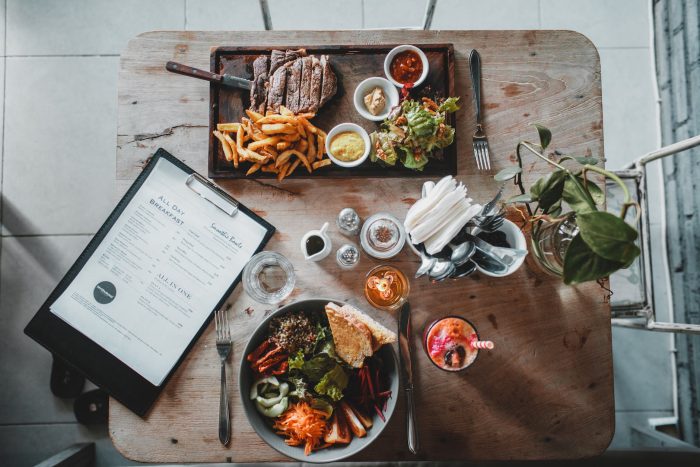There’s so much confusing information out there about how to eat right, especially when it comes to veganism and eating animal products in general. Āyurveda focuses on every aspect of food, including consuming animal products and it’s a fascinating point of view in my opinion and the more I applied to my life the better it got.
There is a popular myth that Āyurveda is vegetarian or vegan. For years, I also believed that an Āyurvedic diet equaled a vegetarian diet, with the consumption of some dairy being allowed (they use a lot of ghee, so it made sense for me). I have been living in an ashram where we were served vegan and vegetarian dishes; whenever I visit Āyurvedic events, the food is always vegetarian, so I was surprised when I started to learn about the uses of animal product in Āyurveda. (And trust me, they use everything!)
While it is true that most people who follow Āyurvedic guidelines are vegetarian or vegan, eating meat in Āyurveda is totally dependent on the individual constitution and personal health care needs. Eating meat is always a personal decision based on your morals, religion, individual needs and health. Normally, Āyurveda calls for an unprocessed, 90-95% plant-based, whole food diet, including small amounts of cultured dairy (mostly yogurt, ghee, buttermilk, and soft cheeses like paneer).
Āyurveda recognizes three primary constitution types—vata, pitta, and kapha—which each have different nutritional requirements. In my personal opinion, one of the biggest reasons people fail when following plant-based diets is because they follow a diet and lifestyle that is constitutionally inappropriate for them, thus leaving them feeling like sh*t.
The 3 macronutrients—carbohydrate, protein and fat—were discovered a couple of hundred years ago, the word protein, derived from the Greek word proteios, means “holding first place” or “primary substance” so naturally there is a belief that holds for long in the collective psyche regarding high-protein foods. Most vegans/vegetarians meet the question daily: How do you consume enough protein? Based on limited and changeable researches, we have been programmed to see animal-based protein as high quality and plant-based protein as inferior. Fact is, all foods, including fruits, vegetables and grains contain proteins. Entire civilizations in history, including ancient Indians, Egyptians, Mexicans, and Chinese obtained their protein from rice, whole wheat and corn.
From an Āyurvedic perspective, thinking in terms of single nutrients such as protein (or fat or specific vitamins for instance) forgets that we need to look at everything as whole, connected and functioning together within a living complexity. Too little or too much of any one constituent inevitably imbalances the system and initiates disease.
What Ayurveda says about food?
The ancient classical text Charaka Samhita states the following:
“The life of all living things is food; the entire world seeks food. Complexion, clarity, good voice, long life, understanding, happiness, satisfaction, growth, intelligence are all because of food.”
Āyurveda accepts meat as a form of food. The ancient Āyurvedic master Charaka says that no other food excels meat in producing nourishing effects in the body (mamsam brimhananam). Ayurveda also gives detailed explanations on meat in eight different categories.
But throughout history animals were not consumed socially and daily, as they are nowdays. The classical texts give numerous descriptions of the properties of various meats, especially their Vata-reducing properties. In general, Āyurveda understands animal flesh as dominant in the element of earth, plus water and fire. These elements can replenish those in whom they are low. In taste, meat is generally sweet, salty, sour, and pungent. Each of these tastes serves different physical (and mental) functions. In the stomach flesh is immediately warming; and after digestion is building in action. These qualities and actions help to balance those with cold, deficient conditions.
The qualities of an animal are developed according to how and what they eat, and the environment they inhabit.
Beyond this however, Āyurveda understands that too much meat aggravates all three doshas and perpetuates disease such as digestive difficulties, the creation and introduction of toxins, and through unbalancing the mind. Digestive difficulties begin with meat’s dense, heavy, congesting qualities, and the fact it’s exceedingly heating. During digestion, meats—especially beef, pork, lamb and fish tend to stagnate the digestion, accumulate toxins, create acidic environment and feed bacteria and inflammation, and encourage putrefaction and ageing.
Āyurveda sees mental imbalance as a primary cause of physical disease. While the flesh of fresh, young, healthy desert-dwelling animals is relatively neutral for the mind, all other meats are seen to encourage anger and agitation (rajas) and stagnancy and stupor (tamas). This is the primary reason why many Hindus, Buddhists, Jainas and Tantrics traditionally avoid meat. Ramana Maharishi advocated the avoidance of meat as a key practice to open and clarify the mind, and move closer to realising one’s nature.
On the contrary, Āyurveda advises the intake of meat as medicine. In Tuberculosis, for example, after healing the digestion, processed meat with certain herbs are advised as medicine. Regarding certain STDs meat is mentioned as a medicine in Āyurveda . Bone broth has been used for thousands of years to build bone tissue and for those suffering from fractures, dislocation of joints and more.
How the Doshas relate to meat consumption and veganism
Vata
Vatas are the least suited to veganism according to Āyurveda. But why is that? Vata is thin, dry, tends to be ungrounded, and doesn’t really have the body mass to be vegan. Most vatas I know who tried being vegan ended up anxious, skinny, and exhausted.
If you are trying to go vegan and have a vata constitution, you might consider going vegetarian instead of vegan and should incorporate cruelty-free, organic dairy products into your diet.
Pitta
Pitta people can be vegan more easily than vatas. With pittas (including myself) I often see the mind dragging the body behind – by this I mean we tend to go extreme with our diets, like raw-only vegan diet and such. While it might work perfectly because out of sheer will pittas are able to get anything done, the body might not agree with it completely. Pitta extreme dietists can be some of the most aggressive people I have ever met because their vata aggravating diet is actually fanning the flames of their pitta temperament.
For me cooking my food helps a lot to decrease its vata tendencies, thus can help to calm down my “pitta psycho”.
Kapha
Of all the constitution types, kapha is the one who can really go and stay vegan long-term. This constitution type holds onto mass easily and has the constitutional strength necessary for a purely plant-based diet. Kapha is still advised to cook their food, as they tend toward sluggish digestion, but as long as they don’t have any major vata imbalances, they can do this diet for the long haul with no issues.
What Āyurveda recommends about consuming meat:
- Do not consume meat on a daily basis. Instead have it moderately, and have more in winter season when you have a strong digestive power.
- Keep in mind your digestive power and constitution while consuming meat. A Kapha predominant person must consume less meat compared to a Vata predominant person.
- If you consume meat, make sure you exercise to keep the body healthy and fit.
- Along with meat, include vegetables and grains in your diet. Make sure you receive all the necessary nutrients.
- Choose organic, hormone-free meat whenever possible.
- Choose quality over quantity. A meatball sized portion of meat eaten daily with vegetables and grains is considered as an appropriate amount that your body can process fully.
- According to Charaka, healthy and wholesome food, even if taken even in proper quantity, does not get properly digested when the individual is afflicted with grief, fear, anger, sorrow,
excessive sleep and excessive vigil. - Food taken in proper quantity provides strength, vigor, good complexion and nurtures the health of the tissues. In order to live healthy, one must live in harmony with his surroundings and follow a diet suitable to one’s own bodily constitution.
One of Āyurveda ’s mottos (which drove me nuts at the beginning) is that “It depends.” One person’s medicine is another’s poison. The human body is a complicated system with complicated habits and processes. We all need to find what works best for us, for our body, mind and soul to make the right decision in every area of our lives, including what we eat and whether or not we decide to consume meat. So should you consume meat according to Āyurveda? It depends. On you to be exact.


 Share on bsky
Share on bsky





Comments are closed.
Read 1 comment and reply